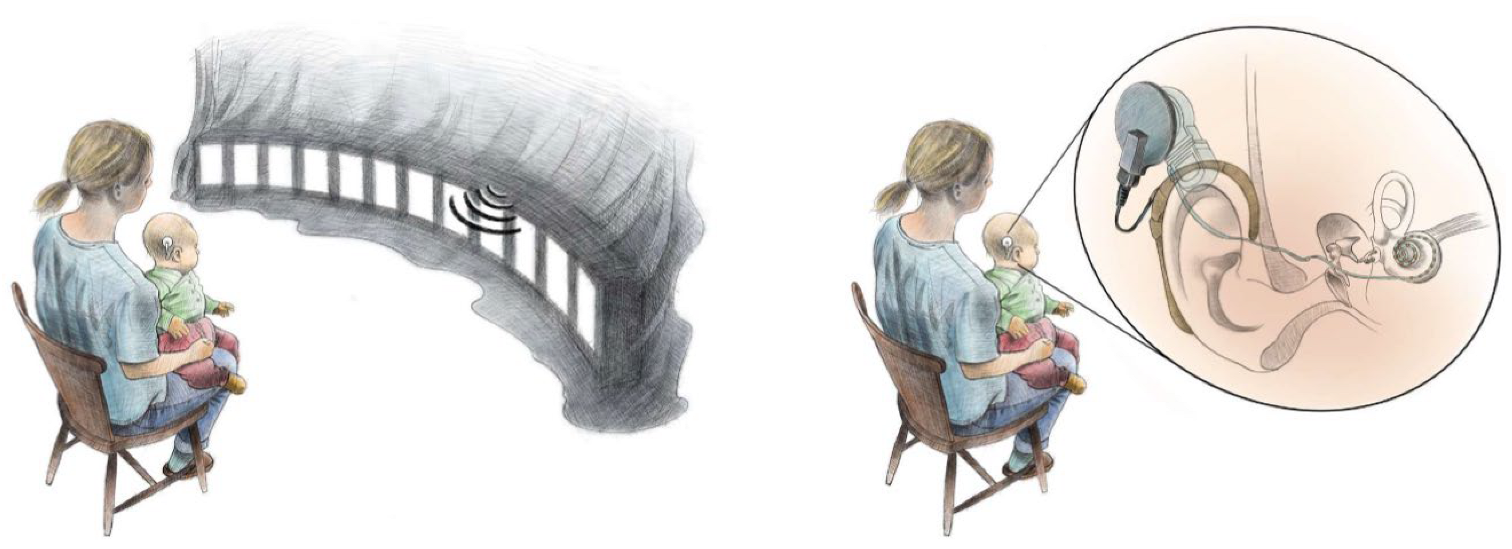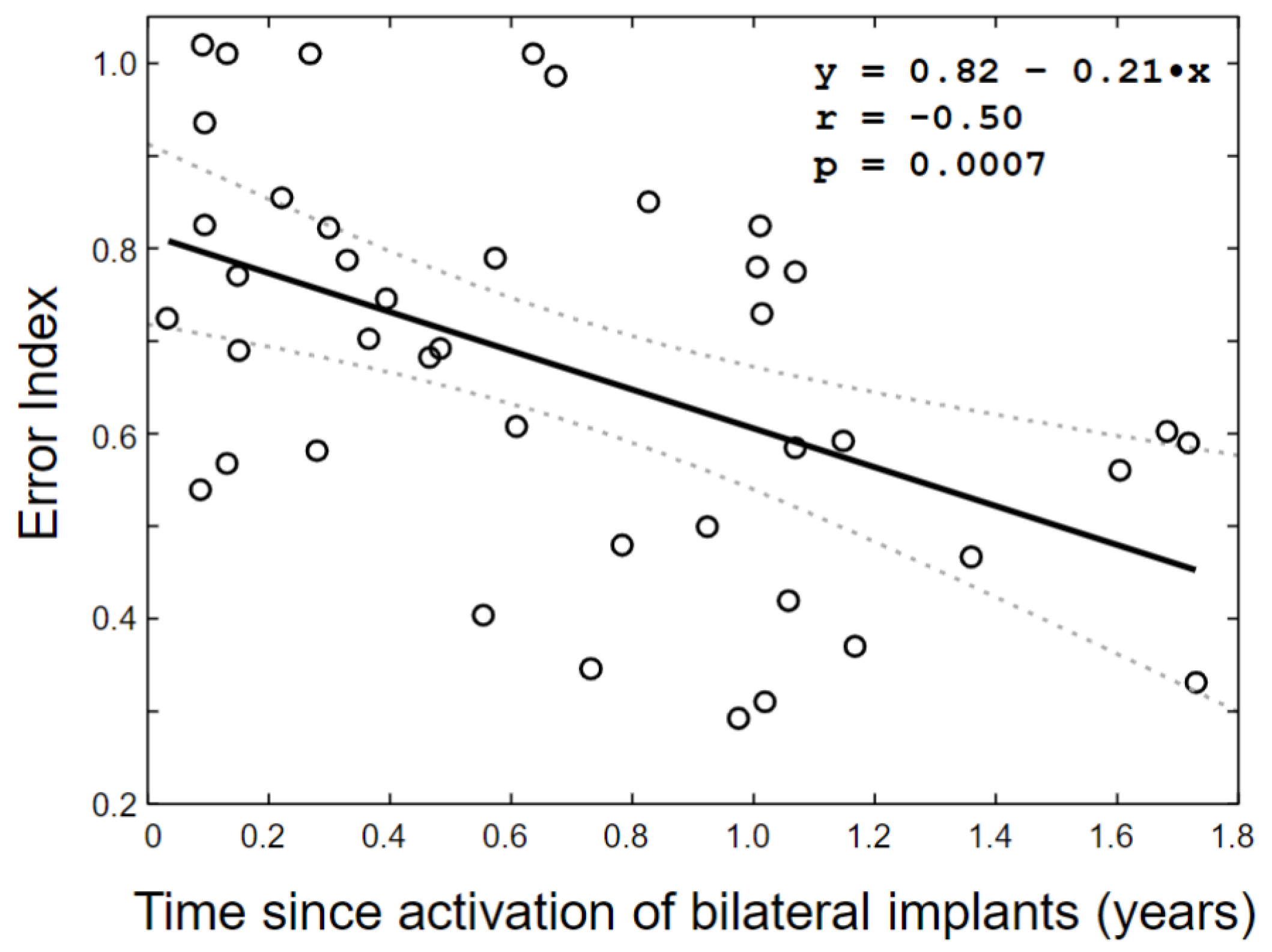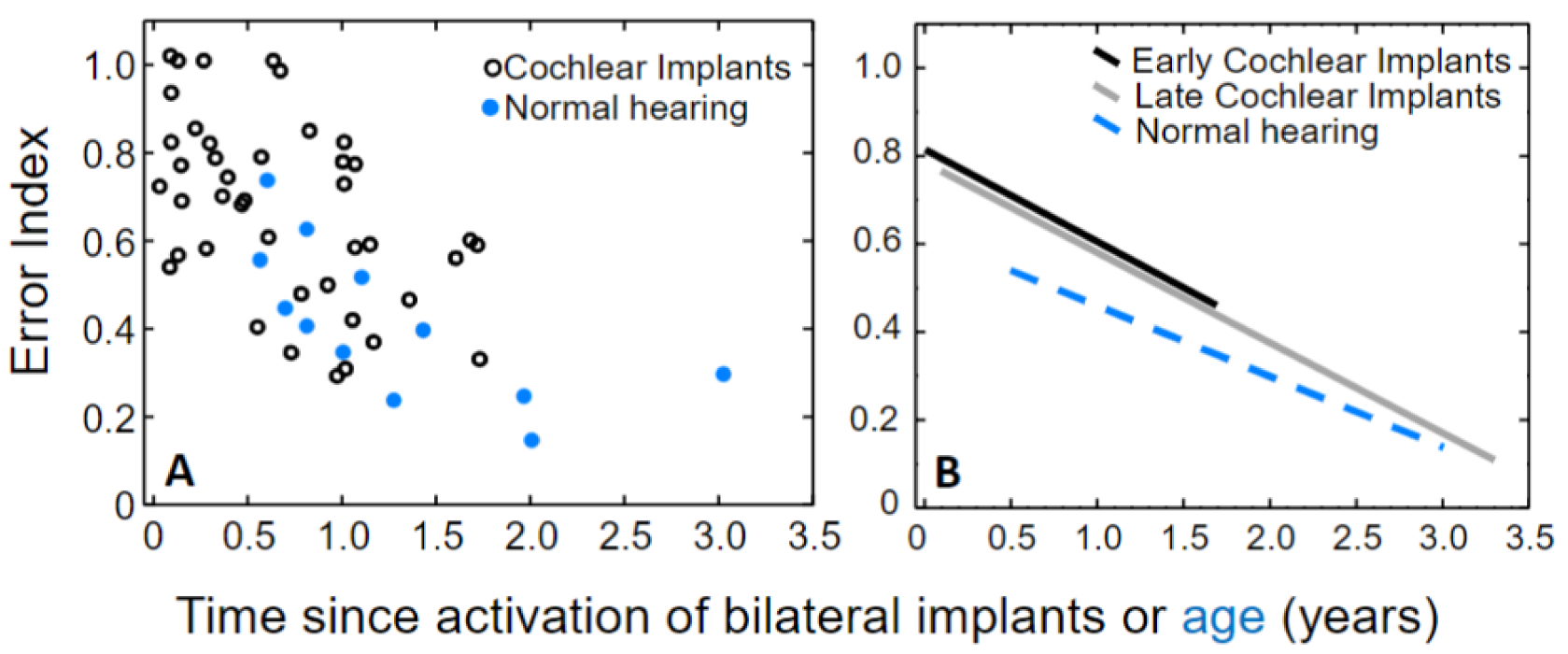Development of Sound Localization in Infants and Young Children with Cochlear Implants
Abstract
1. Introduction
2. Materials and Methods
2.1. Study Design
2.2. Subjects
2.3. Setup, Stimulus and Test Procedure
2.4. Analyses
3. Results
3.1. Development of Sound Localization Accuracy Is Driven by Time since Activation of Bilateral Implants
3.2. Comparison between Children with Early Bilateral Cochlear Implantation and Young Children with Normal Hearing
3.3. Comparison between Children with Early Bilateral Cochlear Implantation and Relatively Late Sequential Bilateral Cochlear Implantation
3.4. Reliability of Sound Localization Measurements
4. Discussion
Author Contributions
Funding
Institutional Review Board Statement
Informed Consent Statement
Data Availability Statement
Acknowledgments
Conflicts of Interest
References
- Middlebrooks, J.C.; Green, D.M. Sound localization by human listeners. Annu. Rev. Psychol. 1991, 42, 135–159. [Google Scholar] [CrossRef] [PubMed]
- Ashmead, D.H.; Clifton, R.K.; Reese, E.P. Development of auditory localization in dogs: Single source and precedence effect sounds. Dev. Psychobiol. 1986, 19, 91–103. [Google Scholar] [CrossRef] [PubMed]
- Olmstead, C.E.; Villablanca, J.R. Development of behavioral audition in the kitten. Physiol. Behav. 1980, 24, 705–712. [Google Scholar] [CrossRef]
- Field, J.; Muir, D.; Pilon, R.; Sinclair, M.; Dodwell, P. Infants’ orientation to lateral sounds from birth to three months. Child Dev. 1980, 51, 295–298. [Google Scholar] [CrossRef] [PubMed]
- Knudsen, E.I. Instructed learning in the auditory localization pathway of the barn owl. Nature 2002, 417, 322–328. [Google Scholar] [CrossRef]
- Hofman, P.M.; Van Riswick, J.G.; Van Opstal, A.J. Relearning sound localization with new ears. Nat. Neurosci. 1998, 1, 417–421. [Google Scholar] [CrossRef]
- Knudsen, E.I.; Knudsen, P.F. Vision calibrates sound localization in developing barn owls. J. Neurosci. 1989, 9, 3306–3313. [Google Scholar] [CrossRef]
- Knudsen, E.I.; Knudsen, P.F. Vision guides the adjustment of auditory localization in young barn owls. Science 1985, 230, 545–548. [Google Scholar] [CrossRef]
- Knudsen, E.I.; Esterly, S.D.; Knudsen, P.F. Monaural occlusion alters sound localization during a sensitive period in the barn owl. J. Neurosci. 1984, 4, 1001–1011. [Google Scholar] [CrossRef]
- Brainard, M.S.; Knudsen, E.I. Sensitive periods for visual calibration of the auditory space map in the barn owl optic tectum. J. Neurosci. 1998, 18, 3929–3942. [Google Scholar] [CrossRef]
- Brainard, M.S.; Knudsen, E.I. Experience-dependent plasticity in the inferior colliculus: A site for visual calibration of the neural representation of auditory space in the barn owl. J. Neurosci. 1993, 13, 4589–4608. [Google Scholar] [CrossRef]
- King, A.J.; Hutchings, M.E.; Moore, D.R.; Blakemore, C. Developmental plasticity in the visual and auditory representations in the mammalian superior colliculus. Nature 1988, 332, 73–76. [Google Scholar] [CrossRef]
- Withington-Wray, D.J.; Binns, K.E.; Dhanjal, S.S.; Brickley, S.G.; Keating, M.J. The Maturation of the Superior Collicular Map of Auditory Space in the Guinea Pig is Disrupted by Developmental Auditory Deprivation. Eur. J. Neurosci. 1990, 2, 693–703. [Google Scholar] [CrossRef]
- Kumpik, D.P.; Kacelnik, O.; King, A.J. Adaptive reweighting of auditory localization cues in response to chronic unilateral earplugging in humans. J. Neurosci. 2010, 30, 4883–4894. [Google Scholar] [CrossRef]
- Zwiers, M.P.; Van Opstal, A.J.; Paige, G.D. Plasticity in human sound localization induced by compressed spatial vision. Nat. Neurosci. 2003, 6, 175–181. [Google Scholar] [CrossRef]
- King, A.J.; Parsons, C.H.; Moore, D.R. Plasticity in the neural coding of auditory space in the mammalian brain. Proc. Natl. Acad. Sci. USA 2000, 97, 11821–11828. [Google Scholar] [CrossRef]
- Asp, F.; Maki-Torkko, E.; Karltorp, E.; Harder, H.; Hergils, L.; Eskilsson, G.; Stenfelt, S. Bilateral versus unilateral cochlear implants in children: Speech recognition, sound localization, and parental reports. Int. J. Audiol. 2012, 51, 817–832. [Google Scholar] [CrossRef]
- Dunn, C.C.; Walker, E.A.; Oleson, J.; Kenworthy, M.; Van Voorst, T.; Tomblin, J.B.; Ji, H.; Kirk, K.I.; McMurray, B.; Hanson, M.; et al. Longitudinal speech perception and language performance in pediatric cochlear implant users: The effect of age at implantation. Ear Hear. 2014, 35, 148–160. [Google Scholar] [CrossRef]
- Houston, D.M.; Miyamoto, R.T. Effects of early auditory experience on word learning and speech perception in deaf children with cochlear implants: Implications for sensitive periods of language development. Otol. Neurotol. 2010, 31, 1248–1253. [Google Scholar] [CrossRef]
- Leigh, J.; Dettman, S.; Dowell, R.; Sarant, J. Evidence-Based Approach for Making Cochlear Implant Recommendations for Infants With Residual Hearing. Ear Hear. 2011, 32, 313–322. [Google Scholar] [CrossRef]
- Karltorp, E.; Eklof, M.; Ostlund, E.; Asp, F.; Tideholm, B.; Lofkvist, U. Cochlear implants before 9 months of age led to more natural spoken language development without increased surgical risks. Acta Paediatr. 2020, 109, 332–341. [Google Scholar] [CrossRef]
- Dettman, S.J.; Dowell, R.C.; Choo, D.; Arnott, W.; Abrahams, Y.; Davis, A.; Dornan, D.; Leigh, J.; Constantinescu, G.; Cowan, R.; et al. Long-term Communication Outcomes for Children Receiving Cochlear Implants Younger Than 12 Months: A Multicenter Study. Otol. Neurotol. 2016, 37, e82–e95. [Google Scholar] [CrossRef] [PubMed]
- Asp, F.; Eskilsson, G.; Berninger, E. Horizontal sound localization in children with bilateral cochlear implants: Effects of auditory experience and age at implantation. Otol. Neurotol. 2011, 32, 558–564. [Google Scholar] [CrossRef] [PubMed]
- Asp, F.; Maki-Torkko, E.; Karltorp, E.; Harder, H.; Hergils, L.; Eskilsson, G.; Stenfelt, S. A longitudinal study of the bilateral benefit in children with bilateral cochlear implants. Int. J. Audiol. 2015, 54, 77–88. [Google Scholar] [CrossRef] [PubMed]
- Mendonca, C.; Campos, G.; Dias, P.; Santos, J.A. Learning auditory space: Generalization and long-term effects. PLoS ONE 2013, 8, e77900. [Google Scholar] [CrossRef]
- Bruijnzeel, H.; Bezdjian, A.; Lesinski-Schiedat, A.; Illg, A.; Tzifa, K.; Monteiro, L.; Volpe, A.D.; Grolman, W.; Topsakal, V. Evaluation of pediatric cochlear implant care throughout Europe: Is European pediatric cochlear implant care performed according to guidelines? Cochlear Implant. Int. 2017, 18, 287–296. [Google Scholar] [CrossRef]
- Armstrong, M.; Maresh, A.; Buxton, C.; Craun, P.; Wowroski, L.; Reilly, B.; Preciado, D. Barriers to early pediatric cochlear implantation. Int. J. Pediatr. Otorhinolaryngol. 2013, 77, 1869–1872. [Google Scholar] [CrossRef]
- Asp, F.; Olofsson, A.; Berninger, E. Corneal-Reflection Eye-Tracking Technique for the Assessment of Horizontal Sound Localization Accuracy from 6 Months of Age. Ear Hear. 2016, 37, e104–e118. [Google Scholar] [CrossRef]
- Asp, F.; Reinfeldt, S. Horizontal sound localisation accuracy in individuals with conductive hearing loss: Effect of the bone conduction implant. Int. J. Audiol. 2018, 57, 657–664. [Google Scholar] [CrossRef]
- Gardner, M.B.; Gardner, R.S. Problem of localization in the median plane: Effect of pinnae cavity occlusion. J. Acoust. Soc. Am. 1973, 53, 400–408. [Google Scholar] [CrossRef]
- van Hoesel, R.J. Exploring the benefits of bilateral cochlear implants. Audiol. Neurootol. 2004, 9, 234–246. [Google Scholar] [CrossRef]
- Noble, W.; Ter-Horst, K.; Byrne, D. Disabilities and handicaps associated with impaired auditory localization. J. Am. Acad. Audiol. 1995, 6, 129–140. [Google Scholar]
- Lachs, L.; Pisoni, D.B.; Kirk, K.I. Use of audiovisual information in speech perception by prelingually deaf children with cochlear implants: A first report. Ear Hear. 2001, 22, 236–251. [Google Scholar] [CrossRef]
- Bess, F.H.; Tharpe, A.M.; Gibler, A.M. Auditory performance of children with unilateral sensorineural hearing loss. Ear Hear. 1986, 7, 20–26. [Google Scholar] [CrossRef]
- Tharpe, A.M. Unilateral and mild bilateral hearing loss in children: Past and current perspectives. Trends Amplif. 2008, 12, 7–15. [Google Scholar] [CrossRef]
- Knudsen, E.I.; Knudsen, P.F. The sensitive period for auditory localization in barn owls is limited by age, not by experience. J. Neurosci. 1986, 6, 1918–1924. [Google Scholar] [CrossRef]
- Polley, D.B.; Thompson, J.H.; Guo, W. Brief hearing loss disrupts binaural integration during two early critical periods of auditory cortex development. Nat. Commun. 2013, 4, 2547. [Google Scholar] [CrossRef]
- Galvin, K.L.; Mok, M.; Dowell, R.C.; Briggs, R.J. 12-month post-operative results for older children using sequential bilateral implants. Ear Hear. 2007, 28, 19S–21S. [Google Scholar] [CrossRef]
- Goupell, M.J.; Stoelb, C.A.; Kan, A.; Litovsky, R.Y. The Effect of Simulated Interaural Frequency Mismatch on Speech Understanding and Spatial Release From Masking. Ear Hear. 2018, 39, 895–905. [Google Scholar] [CrossRef]
- Kan, A.; Litovsky, R.Y.; Goupell, M.J. Effects of interaural pitch matching and auditory image centering on binaural sensitivity in cochlear implant users. Ear Hear. 2015, 36, e62–e68. [Google Scholar] [CrossRef]
- Kan, A.; Goupell, M.J.; Litovsky, R.Y. Effect of channel separation and interaural mismatch on fusion and lateralization in normal-hearing and cochlear-implant listeners. J. Acoust. Soc. Am. 2019, 146, 1448. [Google Scholar] [CrossRef] [PubMed]
- Kan, A.; Stoelb, C.; Litovsky, R.Y.; Goupell, M.J. Effect of mismatched place-of-stimulation on binaural fusion and lateralization in bilateral cochlear-implant users. J. Acoust. Soc. Am. 2013, 134, 2923–2936. [Google Scholar] [CrossRef] [PubMed]
- Goupell, M.J.; Stoelb, C.; Kan, A.; Litovsky, R.Y. Effect of mismatched place-of-stimulation on the salience of binaural cues in conditions that simulate bilateral cochlear-implant listening. J. Acoust. Soc. Am. 2013, 133, 2272–2287. [Google Scholar] [CrossRef] [PubMed]
- Murphy, J.; Summerfield, A.Q.; O’Donoghue, G.M.; Moore, D.R. Spatial hearing of normally hearing and cochlear implanted children. Int. J. Pediatr. Otorhinolaryngol. 2011, 75, 489–494. [Google Scholar] [CrossRef] [PubMed]
- Dorman, M.F.; Loiselle, L.H.; Cook, S.J.; Yost, W.A.; Gifford, R.H. Sound Source Localization by Normal-Hearing Listeners, Hearing-Impaired Listeners and Cochlear Implant Listeners. Audiol. Neurootol. 2016, 21, 127–131. [Google Scholar] [CrossRef]
- Laback, B.; Egger, K.; Majdak, P. Perception and coding of interaural time differences with bilateral cochlear implants. Hear. Res. 2015, 322, 138–150. [Google Scholar] [CrossRef]
- Loiselle, L.H.; Dorman, M.F.; Yost, W.A.; Cook, S.J.; Gifford, R.H. Using ILD or ITD Cues for Sound Source Localization and Speech Understanding in a Complex Listening Environment by Listeners with Bilateral and with Hearing-Preservation Cochlear Implants. J. Speech Lang. Hear. Res. 2016, 59, 810–818. [Google Scholar] [CrossRef]
- Morton, C.C.; Nance, W.E. Newborn Hearing Screening—A Silent Revolution. N. Engl. J. Med. 2006, 354, 2151–2164. [Google Scholar] [CrossRef]
- Smith, R.J.H.; Bale, J.F.; White, K.R. Sensorineural hearing loss in children. Lancet 2005, 365, 879–890. [Google Scholar] [CrossRef]
- Morrongiello, B.A.; Rocca, P.T. Infants’ localization of sounds in the horizontal plane: Effects of auditory and visual cues. Child Dev. 1987, 58, 918–927. [Google Scholar] [CrossRef]
- Bennett, E.E.; Litovsky, R.Y. Sound Localization in Toddlers with Normal Hearing and with Bilateral Cochlear Implants Revealed through a Novel “Reaching for Sound” Task. J. Am. Acad. Audiol. 2020, 31, 195–208. [Google Scholar] [CrossRef]
- Grieco-Calub, T.M.; Litovsky, R.Y. Sound localization skills in children who use bilateral cochlear implants and in children with normal acoustic hearing. Ear Hear. 2010, 31, 645–656. [Google Scholar] [CrossRef]




| Age at Implantation (Years) | Cochlear Implant Model | Sound Processor | Sex | Etiology |
|---|---|---|---|---|
| 0.42 | CI522 | CP1000 | M | Connexin 26 |
| 0.45 | CI522 | CP1000 | M | Genetic testing performed; no mutation found |
| 0.45 | Synchrony 2 Flex 28 | Sonnet 2 | M | Cause not investigated |
| 0.47 | CI612 | CP1000 | F | Cause not investigated |
| 0.48 | CI532 | CP1000 | F | Genetic testing performed; no mutation found |
| 0.51 | Synchrony 2 Flex 28 | Sonnet 2 | F | Unknown; no positive cCMV infection found |
| 0.51 | CI612 | CP1000 | M | Connexin 26 |
| 0.55 | CI522 | CP1000 | F | Connexin 26 |
| 0.56 | Synchrony 2 Flex 28 | Sonnet 2 | F | Connexin 26 |
| 0.58 | CI522 | CP1000 | F | cCMV |
| 0.58 | CI512 | CP1000 | M | cCMV |
| 0.65 | CI612 | CP1000 | M | Cause not investigated |
| 0.76 | Synchrony 2 Flex 28 | Sonnet 2 | F | Genetic testing performed; uncertain causative gene mutation |
| 0.91 | CI612 | CP1000 | M | Genetic testing performed; no mutation found |
| 1.0 | Synchrony 2 Flex 28 | Sonnet 2 | M | Connexin 26 |
| 1.6 | CI612 | CP1000 | M | Cause not investigated |
| 1.8 | CI522 | CP1000 | M | Unknown; no positive cCMV infection found |
| 2.3 | CI612 | CP1000 | F | Cause not investigated |
Publisher’s Note: MDPI stays neutral with regard to jurisdictional claims in published maps and institutional affiliations. |
© 2022 by the authors. Licensee MDPI, Basel, Switzerland. This article is an open access article distributed under the terms and conditions of the Creative Commons Attribution (CC BY) license (https://creativecommons.org/licenses/by/4.0/).
Share and Cite
Asp, F.; Karltorp, E.; Berninger, E. Development of Sound Localization in Infants and Young Children with Cochlear Implants. J. Clin. Med. 2022, 11, 6758. https://doi.org/10.3390/jcm11226758
Asp F, Karltorp E, Berninger E. Development of Sound Localization in Infants and Young Children with Cochlear Implants. Journal of Clinical Medicine. 2022; 11(22):6758. https://doi.org/10.3390/jcm11226758
Chicago/Turabian StyleAsp, Filip, Eva Karltorp, and Erik Berninger. 2022. "Development of Sound Localization in Infants and Young Children with Cochlear Implants" Journal of Clinical Medicine 11, no. 22: 6758. https://doi.org/10.3390/jcm11226758
APA StyleAsp, F., Karltorp, E., & Berninger, E. (2022). Development of Sound Localization in Infants and Young Children with Cochlear Implants. Journal of Clinical Medicine, 11(22), 6758. https://doi.org/10.3390/jcm11226758





